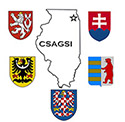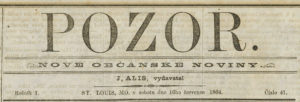Jan Haisman
Early Czech Settler In Chicago
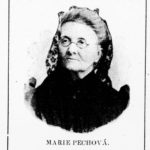 In 1898, in Chicago, the "Old Settlers' Association" was formed. Czechs living in the United States for at least 25 years, and currently living in Chicago, could become members. Anton Pregler became the first Chairperson of the Association. (Not many years later, his property
In 1898, in Chicago, the "Old Settlers' Association" was formed. Czechs living in the United States for at least 25 years, and currently living in Chicago, could become members. Anton Pregler became the first Chairperson of the Association. (Not many years later, his property  located across from the Bohemian National Cemetery would become the location of the Bohemian Home for the Aged).
located across from the Bohemian National Cemetery would become the location of the Bohemian Home for the Aged).
On August 28, 1898, a celebration of the "Old Settlers Association", held in Anton Pregler's garden included the announcement, approved by the reviewing judges of the Association (Frantisek Barcal and Jan Waska (Vaska)) that Marie Pech and Jan Haisman were considered the oldest settlers in Chicago and presented with the Association's gold medal recognizing that achievement. (1)
Jan Haisman (spelling Heismann in Bohemia) was born on March 29, 1832 at Trebycinka #21. Jan's wife, Katerina Vaska (Waska) was born on February 26, 1838 at Trebycinka #27. Jan and Katerina would marry in Svihov on May 15, 1860. Jan, Katerina and son Karl would arrive depart from Bremen to New Orleans on December 13, 1860 aboard the ship anna Delius.
There is an interesting story of Jan between the time of his birth and and the family arrival in New Orleans. (Images below: Portafontium Archives - Svihov)
There are a number of resources which help one discover the story of Jan Haisman. The Kalendar, a yearly publication by August Geringer of Chicago, published in the Czech language detailed his life. The article was published in the Kalendar a year before his death. Our society journal, KORENY, in the Winter 1999 issue, had a translation article by Robert O. Uher of the 1912 Kalendar article. (Read complete article - https://csagsi.org/korenywinter1999haisman/)
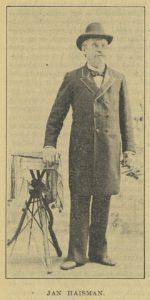 In Bohemia, Haisman was taught the skills of a tailor. As a journeymen he traveled parts of Austria practicing his trade. As civil unrest and conflict spread through the Austro Hungarian Empire in 1848 Jan left with others and traveled to the city of New Orleans. Jan arrived in New Orleans on November 24, 1848 aboard the ship Maria. His trip appears to have begun in Cuxhaven, Germany, and passed through England to New Orleans. (2)
In Bohemia, Haisman was taught the skills of a tailor. As a journeymen he traveled parts of Austria practicing his trade. As civil unrest and conflict spread through the Austro Hungarian Empire in 1848 Jan left with others and traveled to the city of New Orleans. Jan arrived in New Orleans on November 24, 1848 aboard the ship Maria. His trip appears to have begun in Cuxhaven, Germany, and passed through England to New Orleans. (2)
Haisman's time in New Orleans was difficult. He described an initial job, held for a short time, for the pay of eight dollars a month with food and clothing provided. Other jobs occupied his time until 1853 when he became a fire fighter. Yellow Fever ravaged New Orleans in 1853. One article mentions that New Orleans was then nicknamed "Necropolis", city of the dead, as thousands perished. (3) Haisman admits that he too had the Yellow Fever, worked in the New Orleans area for a while longer in some one's shop and later in his own, but then in 1858 returned to Bohemia. (Image Jan Haisman, Kalendar 1912) (4)
The 1912 Kalendar article contains a story which portrays Haisman's difficult time trying to return home. He had no passport, a supposed "friend" he was traveling with took his money and some clothing during the passage and left him with no means to reach home. Haisman described that he received help from a travel agent in Bremen and while staying in a Dresden hotel, he was arrested because he had no passport. He was released from jail and finally made it home. He would eventually be arrested again, taken to Plzen and again released. While home, Jan Heisman married Katerina Vaska, daughter of Prokop Vaska (Waska) and Anna Falout on Mary 15, 1860. Records indicate that a child, Karl, had been born to Katerina on November 29, 1859. (5)
Jan, Katerina and Karl arrived at Port New Orleans from Port Bremen on December 13, 1860 aboard the ship Anna Delius. Their son, Karl, age 11/12 was with them. (6)
The Haisman family, would for a period of time, experience the Civil War in New Orleans. There is a record of a John Heisman, Company K, 20th Regiment, Louisiana Infantry. (7) The “Amerikan Kalendar” article describes that while Jan was pressed upon to be conscripted to the Confederate army, he attempted to not be involved. Jan describes fleeing from work assigned to him, arriving home amidst fires along the Mississippi River and the turmoil caused by the Confederates and Union armies fighting for control.
In an unusual twist of fate, while Jan and his wife (Katerina Waska) are in New Orleans, Katerina’s brother Albert was a Union soldier, enlisting in Massachusetts. They come together when the 31st Regiment of the Massachusetts Infantry joins in the fight to seize New Orleans and control all access to the Mississippi. (8)
Living conditions in New Orleans worsen until Union General Butler gained control of the city. Jan and his family boarded a ship to New York, and from there they would travel to Chicago. Albert Waska, Katerina’s brother, would also reach and live in Chicago. (Note Albert (Vojtech) Waska (Vaska) leads a life in Chicago for which records are available online. He is also mentioned in Czech language books related to Chicago. Albert would even operate a saloon in a building previously owner by Jan Haisman. CSAGSI wrote a summary of his life, as he was one of the eighteen names on a plaque dedicated to the Czech Civil War soldiers who are buried in Bohemian National Cemetery, Chicago. https://csagsi.org/bnc-civil-war-18/ )
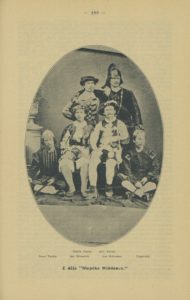 In the 1912 Kalendar article, Jan indicated that his family arrived in Chicago in 1863. Jan found other Czech tailors and would soon find employment, but he also had other interests. The article describes how he joined Slovanska Lipa, on Canal and Van Buren and participated in the construction of their building at that location. Haisman is listed as a founding member of the Chicago branch of Slovanska Lipa, and he worked with other active Czech settlers; Frantisek Barcal, Jan Raisler, and Josef Pech. Haisman also acted with these men in the early plays held in the hall, and when the first hall burned, he continued on in their new location on Taylor Street (1867). Haisman bought, built and sold buildings in the area, including one to his brother in law, Vojtech (Albert) Vaska (Waska). Image (9)
In the 1912 Kalendar article, Jan indicated that his family arrived in Chicago in 1863. Jan found other Czech tailors and would soon find employment, but he also had other interests. The article describes how he joined Slovanska Lipa, on Canal and Van Buren and participated in the construction of their building at that location. Haisman is listed as a founding member of the Chicago branch of Slovanska Lipa, and he worked with other active Czech settlers; Frantisek Barcal, Jan Raisler, and Josef Pech. Haisman also acted with these men in the early plays held in the hall, and when the first hall burned, he continued on in their new location on Taylor Street (1867). Haisman bought, built and sold buildings in the area, including one to his brother in law, Vojtech (Albert) Vaska (Waska). Image (9)
The 1870 and 1880 Census records do list the Haisman family:
1870 Illinois Cook Chicago Ward 9 Pages 111-112
John Hesmer 38, Katie 32, Charles 10, Adolph 6, Josephine 5, Emelia 3, Louisa 1/12
Same House Katerina's parents
Peter Worker (Waska) 60, Ann 59, Joseph 24, Ann Falout 22
1880 Illinois Cook Chicago 090 Page 46 250 Ewing
John Haissen 48, Catherine 42, Charles 21, Adolph 15, Josephine 14, Emelia 12, Wlaste 10, Bertha 8, Nellie 6, Edward 4, Benjamin 2, Emanuel 8/12
The financial panic of 1893 nearly ruined Haisman. Along with so many others, his holdings and finances disappeared. Haisman did describe that during this time, when his finances and holdings were in disarray, he did receive land in Iowa in exchange for some of the properties he once held. While he described a difficult route to closure, he did exchange his Iowa land for 24 lots in Chicago. (Ancestry does have a listing of a John Heisman owning land in Lime Creek, Washington County, Iowa) (10) Haisman gives credit to Peter Brabec, whom he describes as a cousin (Find A Grave 149974469), born in Prestice, and living in Chicago since 1865, for helping him exchange the Iowa land for Chicago lots. Brabec would buy six of those lots from Haisman.
At the time of the 1900 Census Jan Haisman had finally settled into his last home on 12th Street in Chicago.
1900 Illinois Cook Chicago Ward 9 D0223 Page 4 762 12th St.
John Haisman 66, Catherine 62, Charles T. 39, Emma B. 30, Louisa W. 28, Edward F. 25, Benjamin H. 23, Emil G. 20, Victor H. 18, Charles W. Pleschner 26, Birdie M. 25, Sylvia 2
1910 Illinois Cook Chicago Ward 11 D0652 Page 31 1745 12th St.
John Haisman 78, Catherine 72, Louise 34, Edward 31
Living at 1743 13th Street - Son Adolph and his family
The 1912 Kalendar article does not provide much information on this time period.
Jan Haisman died in 1913. His wife, Katerina, died in 1915. They are buried in Chicago's Bohemian National Cemetery, along with several children in a family grave site. https://www.findagrave.com/memorial/195814637/john-haisman
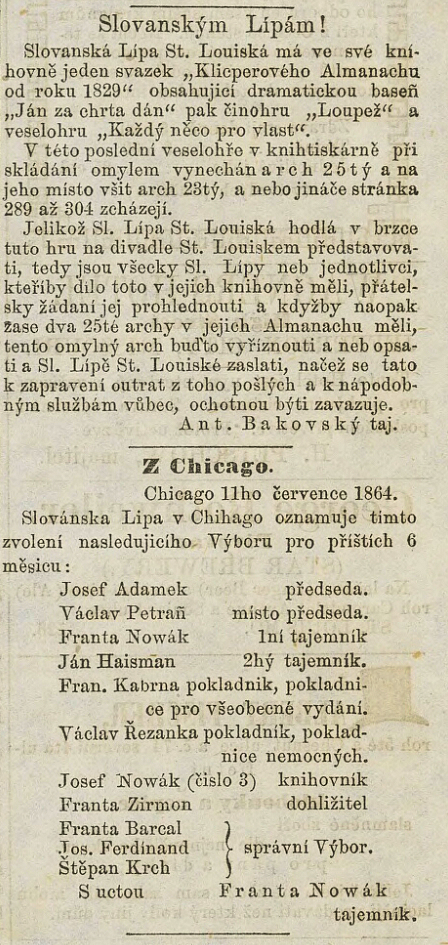

Image Above - Right
Chicago Newspaper "Slavie" January 14, 1913 obituary for Jan Haisman
Image Above - Left
St. Louis Newspaper - Pozor - July 16, 1864 - Page 3 - Describing the organization of Slovanska Lipa in Chicago, with Jan Haisman as one of its board members.
Chicago July 11, 1864 Slovanska Lipa in Chicago announces the election of the following Committee for the next 6 months:
Josef Adamek - chairman
Vaclav Petran - acting chairman
Franta Nowak - first secretary
Jan Haisman - 2nd secretary
Fran. Kabrna cashier, cashier for general issues.
Vaclav Rezanka treasurer, cash register for the sick. (Google Translation)
Josef Nowak (number 3) librarian
Franta Zrimon - supervisor
Franta Barcal - Administrative Committee
Jos. Ferdinand - Administrative Committee
Stepan Krch - Administrative Committee
Sincerely, Franta Nowak, Secretary
The Chicago Evening Post Newspaper, Chicago, Illinois, Saturday, October 19, 1872, Page 6
The Republicans of the Ninth Ward will meet this evening at Haisman's Hall, No. 445 South Canal Street. Hon. J.D. Ward, S.K. Dow, and M. M. Miller address this meeting.
The Inter Ocean Newspaper, Chicago, Illinois, Monday, January 29, 1900, Page 6
New Republican Club Formed
Bohemian Voters of the Ninth Ward Perfect Organization
A meeting of the Bohemian Republicans of the northern end of the Ninth Ward, held yesterday afternoon at Sistek's hall, Twelfth and Paulina streets, resulted in the organization of a club to be known as the North End Bohemian republican Club of the Ninth Ward. The officers elected are: Anton Dvorak, president; John Haisman, vice president; Joseph A. Smejkal, secretary; adolph A. Bastar, treasurer; Joseph A. sikuta, sergeant at arms. Speeches were made by Joseph A. Smejkal, J.Fl Stepina, J.A. Sikuta, and others. The object of the organization is to further the interests of the Republican party, and to assist in the election of good men to office.
https://flps.newberry.org/
The Chicago Foreign Language Press Survey was published in 1942 by the Chicago Public Library Omnibus Project of the Works Progress Administration of Illinois. The purpose of the project was to translate and classify selected news articles that appeared in the foreign language press from 1855 to 1938. The project consists of 120,000 typewritten pages translated from newspapers of 22 different foreign language communities of Chicago.
From the Foreign Language Press Survey - Three articles listing Jan Haisman
p. 1--Lately our countrymen have manifested creditable spirit of enterprise.
We have a whole group of genuine Bohemian enterprises of various kinds, and most of them rest upon good, firm foundations, so that money invested in them is assured suitable profit.
A promising undertaking, guaranteeing safety of investment and considerable clear profit, is the Builders Brick Company, whose product will soon be on the market. This company is deserving of detailed mention for it is a truly Bohemian undertaking.
The idea of its organization originated among Bohemian builders and contractors.
Bohemians are managing it, Bohemian money is invested in the undertaking, and Bohemians will be its main supporters.
A meeting was held last Thursday by the company at which interesting and encouraging reports were made.
The company is capitalized at $75,000 of which almost $46,000 has been subscribed for and paid in.
At the above mentioned meeting it was resolved to forty acres of land in Chicago Heights, Ill.
These grounds embrace an almost inexhaustible deposit of fine brick clay, and trade experts estimate that it will be possible to operate at least thirty years, at a daily production of one hundred and fifty thousand bricks.
The cost of the ground and the furnishing of the factory in which the most modern and practical machinery will be installed is estimated at $75,000. A further outlay of about $25,000 will be needed for wagons, horses, etc. The company will issue bonds to raise the additional sum needed.
Anyone may become a shareholder in the company by purchasing stock which costs $100 per share and which is limited to twenty shares to any individual. Almost all Bohemian builders, contractors and architects are shareholders, so that the company's product is assured a market; and there is no necessity of spending any money on advertising in order to secure business.
The profit on brick at present prices is very great and will be satisfactory even if the price should drop.
About one hundred Bohemian citizens, who have acquired shares of the company, have taken advantage of the benefits offered by the company and all of the shares will surely be subscribed for very soon.
As soon as the business is in operation, the value of the shares will rise.
At the quarterly meeting, sample bricks, made of clay, from the ground which will be bought, were exhibited, and met with the approval of experts in every respect. It should also be mentioned that Chicago Heights and the future Bohemian brickyard are situated conveniently on a railroad, and transportation from there is rapid and at low cost.
As is known, The Chicago Terminal Railroad extends from Chicago Heights through our California and Pilsen, and our builders and contractors can be supplied with brick at low cost.
The board of directors is composed of the following: F. C. Layer, president; T. B. Dibelka, vice-president; Adolf Lonek, secretary; Richard Dusil, treasurer. Members of the board: A. F. Rusy, Frank Sedlak, Frank Novy, John Haisman
p. 1--Lately our countrymen have manifested creditable spirit of enterprise.
We have a whole group of genuine Bohemian enterprises of various kinds, and most of them rest upon good, firm foundations, so that money invested in them is assured suitable profit.
A promising undertaking, guaranteeing safety of investment and considerable clear profit, is the Builders Brick Company, whose product will soon be on the market. This company is deserving of detailed mention for it is a truly Bohemian undertaking.
The idea of its organization originated among Bohemian builders and contractors.
Bohemians are managing it, Bohemian money is invested in the undertaking, and Bohemians will be its main supporters.
A meeting was held last Thursday by the company at which interesting and encouraging reports were made.
The company is capitalized at $75,000 of which almost $46,000 has been subscribed for and paid in.
At the above mentioned meeting it was resolved to forty acres of land in Chicago Heights, Ill.
These grounds embrace an almost inexhaustible deposit of fine brick clay, and trade experts estimate that it will be possible to operate at least thirty years, at a daily production of one hundred and fifty thousand bricks.
The cost of the ground and the furnishing of the factory in which the most modern and practical machinery will be installed is estimated at $75,000. A further outlay of about $25,000 will be needed for wagons, horses, etc. The company will issue bonds to raise the additional sum needed.
Anyone may become a shareholder in the company by purchasing stock which costs $100 per share and which is limited to twenty shares to any individual. Almost all Bohemian builders, contractors and architects are shareholders, so that the company's product is assured a market; and there is no necessity of spending any money on advertising in order to secure business.
The profit on brick at present prices is very great and will be satisfactory even if the price should drop.
About one hundred Bohemian citizens, who have acquired shares of the company, have taken advantage of the benefits offered by the company and all of the shares will surely be subscribed for very soon.
As soon as the business is in operation, the value of the shares will rise.
At the quarterly meeting, sample bricks, made of clay, from the ground which will be bought, were exhibited, and met with the approval of experts in every respect. It should also be mentioned that Chicago Heights and the future Bohemian brickyard are situated conveniently on a railroad, and transportation from there is rapid and at low cost.
As is known, The Chicago Terminal Railroad extends from Chicago Heights through our California and Pilsen, and our builders and contractors can be supplied with brick at low cost.
The board of directors is composed of the following: F. C. Layer, president; T. B. Dibelka, vice-president; Adolf Lonek, secretary; Richard Dusil, treasurer. Members of the board: A. F. Rusy, Frank Sedlak, Frank Novy, John Haisman and John Rus.
Old settlers whose services to the Czech community in Chicago have been invaluable, like to remember former times when they had to work hard and unrelentingly, not only to found an existence for themselves, but also to prepare and insure a better future for those who came after them to the land of liberty, to continue the work which they had begun. All of Czech Chicago gladly joins with them in their reminiscences, which are revived in annual gatherings, at which congenial conversation and pleasant, plain entertainment are offered.
One such gathering took place yesterday, celebrating the twentieth anniversary of the Czech Old Settlers' Association. This gave the picnic a special luster, and made it one of the most successful in years. It was held in the Pilsen Brewery Park, the usual place for these affairs. Innumerable Czech settlers are members of the Association, including many who left town years ago. Even young people belong, thus symbolizing the future, while the older people form the background, representing the past and the present. These annual celebrations reflect the peaceful, harmonious, sociable life in the settlement, as the old settlers knew it.
Nevertheless, yesterday's picnic reflected the grave import of the present time. A patriotic air pervaded the festival. Aged men and women frankly expressed the wish that "the man with the scythe" might wait for awhile, until the war ended with a victory for the United States, so that the old people could rejoice in the liberation of the world, and, last but not least, in the rescue of Czechoslovakian territory from subjugation.
The festive picnic opened, as always, at 11 A. M., and soon groups of people, most of whom were members of the Association, were seen in lively conversation, for many had not met for a whole year. There was a parade with a markedly patriotic aspect. It was led by John Sokol, head of the Scouts. He wore a mask, and was dressed as "Uncle Sam". Girls from the Red Cross marched, followed by members of the Association.
A new flag was raised over the park pavilion, after which "Uncle Sam" recited the oath of allegiance in English. It was repeated by the audience in the Czech language. This was a solemn moment.
Mr. Anton Pregler enthusiastically outlined the activities of the Association. "My esteemed fellow citizens, fellow members of the Czech Old Settlers' Association," he began. "I wish to say only a few sincere words to you....We are celebrating the memory of July 14, 1898, when our Association was founded.....Conforming with our statutes, the Association is managed by a directorate of six men and six women.....
"Sixteen men have addressed former gatherings at various times, usually after the main ceremonies were over. Among those speakers were Charles Vopicka, V. Kaspar, Robert Pitte, Judge J. Z. Uhlir, J. Kostner, Joseph Cermak, and Judge Kickham Scanlan of the County Court. Mrs. Marie Steiskal, who was a member of the directorate twenty years ago, and Mrs. Margaret Stuchlik, also spoke on various occasions.
"At each picnic a gold medal was given to the oldest settlers. The first gold medal was awarded to Mrs. Marie Pecha, who was at that time a ward of the Institute for the Blind, 19th Street and Douglas Park Avenue (sic). She came to America in 1853. Mr. John Haisman one of the recipients of the medal, came to this country in 1848.
"Charity has been the guiding spirit of the Association. The members have not paid any dues during the entire twenty years, yet over 5,000 membership emblems have been given away, various expenses have been paid, and annual picnics have been arranged with free admission. Over 10,000 albums have been given away. About $3,000 was contributed to the maintenance of various charitable institutions, such as the Bohemian Old People's Home and Orphan Asylum, the institute at Lisle, Illinois, and the Catholic Orphanage, where an extra room, a memorial to the Association, is maintained for sick children. The Association sent 500 crowns for the sufferers from the flood in Bohemia in 1902. That money was distributed by Mr. F. Korbel. The Association donated $500 to the Czech Hospital in Chicago, and $50 to the immigrant home at Baltimore, Ohio. The Matice Vyssiho Vzdelani (Central Organization for Higher Education), and the American Red Cross have also received contributions. The Association became a member of the Red Cross under the special sponsorship of President Wilson. Our Association has contributed on many other occasions, and can well be proud of its record. As chairman of the board of directors, I wish to thank everybody for their co-operation.....Let us remember the members who have died....." Mr. Pregler closed with a wish that the silver jubliee of the Association might be celebrated.
Mr. Otto Fuerst Followed. During and after his address, there were tears in the eyes of almost everybody present. His words went to the hearts of the old people; they were the very echo of their innermost desires.
These moments of emotion did not however, last very long because the majority of the picnickers gradually congregated about the kitchen, and at the spots where delicious drinks were being served.
The dance of the oldest couple was an important feature. Mr. Joseph Sramek, 83, and Mrs. Therese Doskocil, 81, in spite of their age, gave an excellent account of themselves because they pranced about with youthful vigor, and chatted gaily. They were each presented with a large mug designed in true Bohemian style.
One cannot imagine a Czech Old Settlers' picnic without some funny entertainment being offered at it. There was plenty of fun at this one. The main attraction was the appearance upon the floor of a strange man whom everyone would have guessed to be at least one hundred years old. He hopped about as if he were a boy, and danced with seventy-two-year-old Mrs. Catharine Nemrava until she was breathless. Other dancers, and those looking on, soon began to express doubt about the man's real age. Though unmasked and revealed as Mr. Belohlavek, Jr., he still stuck to his "old age," and continued to romp about as a "centenarian," until the picnic closed at 11 P. M.
Yesterday the association which has for its aim to provide for the building of the Old People's Home and the Orphanage met in the lower hall of the Bohemian English Liberal School on Eighteenth Street. The meeting was well attended, and its results were really satisfactory. It is evident that in this last year much effective work has been done to advance the undertaking, and it cannot be denied because of these activities the goal is almost attained. This must surely please every sincerely charitable Bohemian.
The meeting was called to order by Mr. Frydl, the chairman of the Association. As has been said above, there was a large attendance of the delegates [of the societies which form the Association]. After the reading of the minutes of the previous meeting by the secretary, Mr. Karel Musil, communications received were read. In these communications the names were announced of the newly elected delegates. We observed that the lodges and the corporations had selected intelligent and capable representatives, who will be able to do much for the good of the Association.
Mr. Suchy, secretary of the executive committee, read the notes of the executive committee's meeting held last Sunday. The meeting then proceeded with the election of officers. Mr. Jan Pech was unanimously chosen president. Mrs. Liskova was unanimously elected vice-president. The election of a secretary was a bit more difficult because many of those nominated hesitated to accept this thankless office. However, Mr. R. Svacha finally did accept the nomination and was unanimously elected. Mr. O. Stybr was elected financial secretary, and Mr. Antonin Zahrobsky treasurer. The managing committee of five members was chosen as follows: Messrs. Psenka, Tokstein, Charvat, and Haisman and Mrs. Pech. Messrs. Novak, Musil, and Tucek were elected to the auditing committee. The entertainment committee will be named at the next meeting by the newly elected president.
The Association can only congratulate itself upon the result of this election. There is no doubt that the general public will also be pleased with the results and will show its approval by generous gifts to the Home and the Orphanage. Several proposals for the good of the Association were offered after the election of officers had been completed. Those which were recognized as beneficial to the Association were accepted.
Receipts of the evening amounted to the substantial sum of $1,059.10; disbursements, none. [After this had been announced], the meeting was adjourned.
References:
1. "Pamatnik Starych Ceskych Osadniku, Jan Habenicht & Anton Pregler, Tisek Narodni Tiskarny, Loomis Street, Chicago, August 1899.
Images: Birth Jan Haisman, Katerina Vaska, Marriage Jan and Katerina: https://www.portafontium.eu/contents/register/soap-pn/cirkev-rimskokatolicka/svihov
2. Ancestry.com, New Orleans Passenger List Quarterly Abstracts, 1820-1875 - Original data - Quarterly Abstracts of Passenger Lists of Vessels Arriving at New Orleans, Louisiana, 1820-1875,. M272., 17 rolls. Records of the U.S. Customs Srvice, Record Group 36. National Archives and Records Administration, Washington, D.C.
4. "Amerikan - Narodni Kalendar - Na Rok - 1912", Published by August Geringer, Chicago, Illinois, 1912, Page 273.
5. https://www.portafontium.eu/iipimage/30069378/svihov-09_0200-o?x=-16&y=103&w=1057&h=446
6. (Ancestry) Quarterly Abstracts of Pssenger Lists of Vessels Arriving at New Orleans, Louisiana, 1820 - 1875. M272, 17 Rolls. Records of the U.S. Customs Service, Record Group 36. National Archives and Records Administration, Washington, D.C.
9. Image - Jan Haisman with other actors - "Amerikan - Narodni Kalendar - Na Rok - 1907", Published by August Geringer, Chicago, Illinois, 1912, Page 283.
10. Ancestry - U.S. Indexed County Land Ownership Maps, 1860-1918, originals microfilmed by the Library of Congress, Washington, D.C.
